Czichos H., Saito T., Smith L.E. (Eds.) Handbook of Metrology and Testing
Подождите немного. Документ загружается.

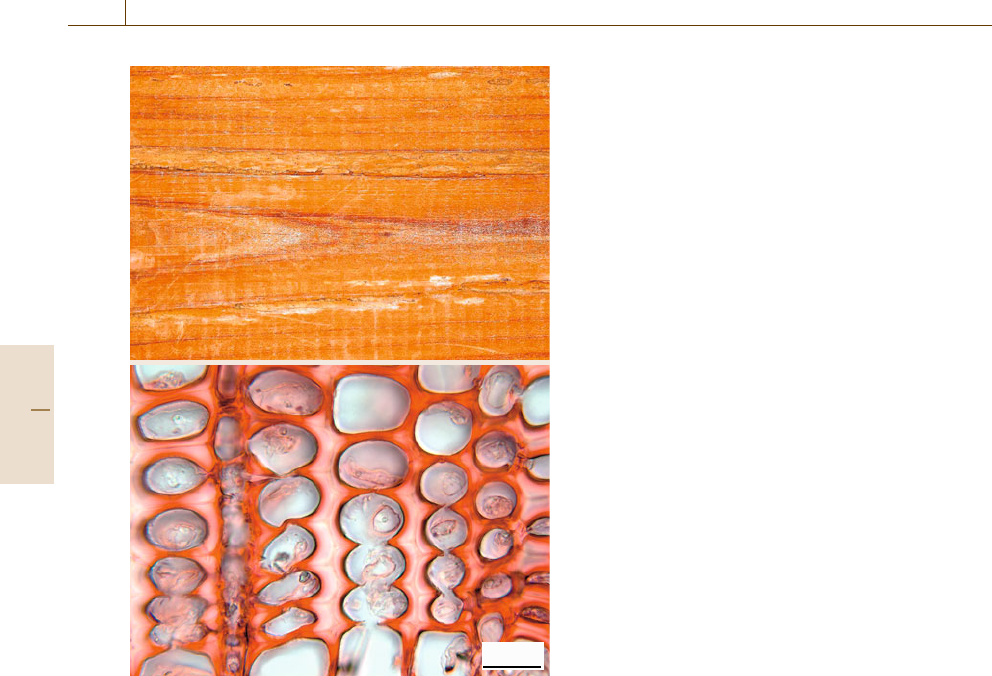
778 Part D Materials Performance Testing
a)
b)
50µm
Fig. 14.3 (a) Longitudinal cut of wood (Picea sp.) decayed
by white rot causing fungi; this picture shows an example
for so called pocket rot, because white pockets of decay
can be seen on the wood surface. (b) Cross section of wood
(Picea sp.) decayed by white rot causing fungi (Courtesy
of Swedish University of Agricultural Science, Uppsala,
Sweden)
the sugars deposited in the parenchymatic tissue of the
wood. The fungi can access these sugars only in cells that
have been damaged (by force: felling or processing). By
their metabolic products and colored spores they stain
the wood and lead to loss in value.
A good overview on different forms of decay is
also given by Wilkinson [14.9], and a more detailed de-
scription of macro- and microscopic observations can be
found, e.g., in Anagnost [14.10].
As outlined above (see on sap stain, blue stain)some
microorganisms cause only discoloration of wood while
others also lead to mass loss of the wooden substance.
Mass loss and therefore density loss is the more critical
parametersince it is related to strength loss [14.11]which
is especially undesirable for a construction and build-
ing material. Therefore laboratory methods determine
the mass of a woodenspecimen before and after exposure
to fungi which have been selected as aggressive wood-
deteriorating organisms under laboratory conditions.
To measure mass loss at a set point in time requires
the drying of the wooden material to 0% wood moisture
content. This drying process kills living fungal cells and
can lead to severe cracking of the wood structure. The
rheological properties of the wood also lead to irrevo-
cable physicochemical changes while drying. Therefore
the determination of mass loss by weighing is not a non-
destructive method.
Nondestructive Testing Methods
to Detect Fungal Decay
Nondestructive methods are required when the changes
of wood structure have to be monitored over a longer
time period or when the timber to be tested is already
part of a construction. Bodig [14.12] listed the following
nondestructive methods as examples.
•
Sonic stress wave
Stress waves are generated either through an im-
pact or by a forced vibration. Usually, with this
method either the speed of sound or the vibration
spectrum is measured. The dynamic modulus of elas-
ticity (MOE) can be calculated from these measure-
ments.
•
Deflection method (static bending technique)
The deflection is measured at a safe load level
which does not lead to rupture of the test piece. The
static MOE can be calculated from these measure-
ments.
•
Electrical properties
The products of fungal metabolism are carbon diox-
ide and water of which the latter leads to a higher
moisture content in the wood. This method is based
on the relationship between moisture content and
electrical resistance of wood.
•
Gamma radiation
is tool for quantifying decay. It is also employed as
a tracing method for quantifying the distribution of
preservatives in wood. One of the limitations of this
method is the regulations associated with the use of
a radioactive source.
•
Penetrating radar
This method is currently being developed for wood
products. The method bears the potential to detect
and quantify degradation at inaccessible locations.
Part D 14.2
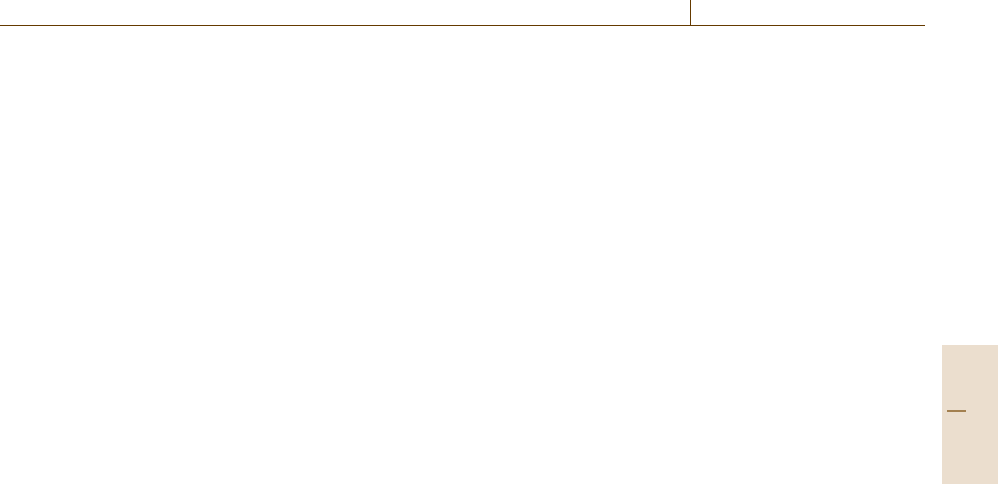
Biogenic Impact on Materials 14.2 Biological Testing of Wood 779
•
X-ray method
is mostly used in the laboratory or in production lines
due to the bulky nature of the x-ray source and the
measuring equipment.
Similar techniques (transversevibration techniques, stat-
ic bending techniques) are listed in a review on nonde-
structive testing for assessing timbers in structures by
Ross and Pellerin [14.13].
Also infrared, x-ray and gamma-ray computerized
tomography have been employed to visualize microbio-
logical attack in timber. However, the techniques are
mostly very cost intensive.
The oldest nondestructive test method is the visual
estimation with the bare eye followed by rating the de-
cay or discoloration of the specimens. This inexpensive
method provides the expert with a lot of information. It
is mainly applied when large numbers of specimens in
a test field have to be assessed. An experienced evalu-
ator will be able to rate the intensity of decay as well
as to determine which type of decay has infested the
wood.
Testing Wood for Different Use Classes
While the environmental conditions in use classes 1
and 2 do not provide the necessary amount of water to
allow growth of microorganisms, the use classes 3 and
4 are the more relevant for testing microbiological decay
above ground and in ground contact.
Testing Wood for Use Class 3.
Field Tests. Use class 3 is a very complex class. Depend-
ing on the local climatic conditions, the dimensions of
the cross section of construction parts and their actual lo-
cation (near to the ground, mostly covered under a roof
etc.) it may reach from nearly use class 2 to use class 4.
Many test methods have been developed for use class 3,
intended to accelerate the attack by microorganisms and
thus to give results in relatively short times. Some of
them even use additional artificial wetting regimes. But
all of them are simply reflecting different situations in
use class 3. They are not accelerated test methods, ex-
cept when they are used under extremely severe tropical
conditions.
Three of these methods shall be described exemplar-
ily.
•
EN 330: Wood preservatives – Field test method
for determining the relative protective effectiveness
of a wood preservative for use under a coating
and exposed out of ground contact: L-joint method.
With slight modifications the AWPA E9-06 Standard
Field Test for the Evaluation of Wood Preservatives
to be Used in Non-Soil Contact is comparable to
this method. Stylized corners of window frames with
mortise and tenon (L-joints) are treated with a wood
preservative by a method recommended by the sup-
plier of the preservative (double vacuum, dipping or
others). After drying of the preservative the mortise
members are sealed at the cross section opposite to
the mortise and the whole L-joints are coated with an
alkyd reference paint or a paint system provided by
the supplier of the preservative. Then the specimens
are exposed in the field on racks in a position slightly
leaned backwards. Prior to exposure the top coat will
be broken at the joint by opening and reclosing the
joint. In at least annually intervals the L-joints are vi-
sually examined for occurrence of wood-disfiguring
and wood-destroying fungi. For the assessments the
joints are taken apart in order to check the situation
within the joint. The fungal attack is rated accord-
ing to a 5-step rating scale reaching from 0 (sound)
to 4 (failure). After 3 and 5 years of exposure ad-
ditionally exposed specimens are assessed destruc-
tively by cutting the joint members lengthwise as to
detect interior rot in the wood. The mean service-life
of a series of L-joints will be determined by adding
the service-life of the individual members of the se-
ries after the last member is rated failureand dividing
that number by the number of parallels in the test.
•
ENV 12037: Wood preservatives – Field test method
for determining the relative protective effectiveness
of a wood preservative exposed out of ground con-
tact – Horizontal lap-joint method. AWPA E16-09
Field Test for Evaluation of Wood Preservatives to
be Used Out of Ground Contact: Horizontal Lap-
Joint Method uses the same method with only slight
modifications. Objective of the method is to evaluate
the relative effectiveness of the preservative, applied
to jointed samples of pine sapwood by a treatment
method relevant to its intended practical use. In con-
trast to the L-joint method, the wood preservative is
applied without subsequent surface coating. Bound
together with cable straps the jointed specimens are
exposed on racks outdoors not touching the ground.
The joint functions as a water trap, thus providing
optimal wood moisture conditions for the attack by
wood-destroying fungi for relatively long periods.
Again the specimens are examined visually at least
annually using a rating scale for the fungal attack.
•
AWPA E18-06 Standard field test for evaluation of
wood preservatives intended for use in category 3B
Part D 14.2
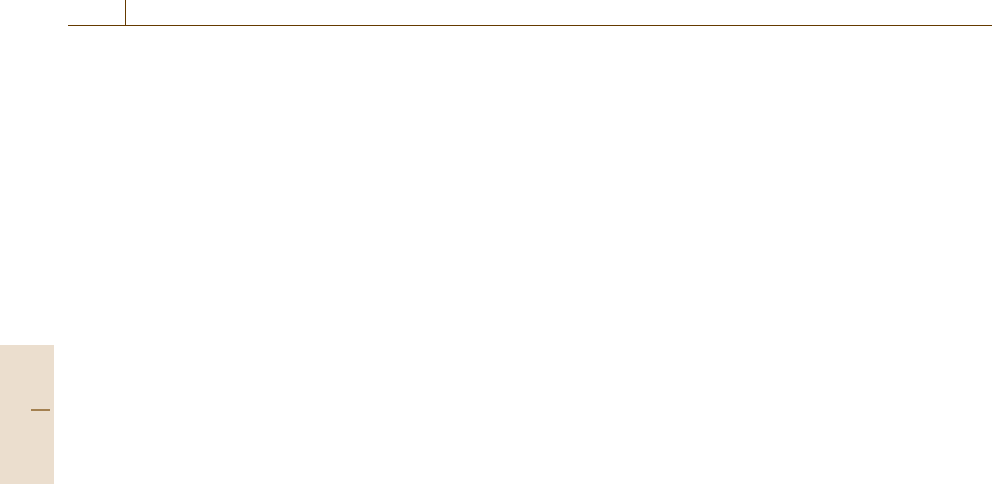
780 Part D Materials Performance Testing
applications exposed, out of ground contact – Un-
coated ground proximity decay method. Test speci-
mens of pine or other softwood species, measuring
125×50×19 mm
3
are treated with a wood preserva-
tive according to the recommendation of the supplier
of the preservative. After drying of the preservative
the specimens are exposed outdoors, lying horizon-
tally on concrete blocks measuring 40× 20 × 10 cm
3
which are placed on the ground. The arrangement
is covered by an open frame with a horticultural
shade cloth on top. The distance between specimens
and cloth is about 3 cm. The cloth is intended to
protect the specimens from direct sunlight. It also
reduces the drying of the specimens and provides
an increased relative humidity within the frame. The
specimens are checked for fungal attack at fixed in-
tervals. The attack is rated according to a rating
scale.
The purpose of these methods is to expose the
treated specimens to the complete range of microorgan-
isms occurring under natural conditions. That means,
all possible microorganisms, like bacteria, yeasts and
fungi get to attack the wood. According to the lo-
cal climatic conditions the specimens are subjected to
changing temperatures, precipitations and relative hu-
midity. All microorganisms metabolizing wood have
their specific optimum temperatures and wood moisture
content. Therefore a natural succession of microorgan-
isms occurs which cannot be achieved in the labora-
tory. To some of the organisms the active ingredients of
the wood preservatives may be poisonous, while other
microorganisms may detoxify them or in the case of
organic substances may even use them as a nutrient
source.
All these methods provide data on the performance
of wood preservatives. But as the local conditions of tem-
perature and precipitation of the exposure sites can be
extremely different even at relatively small distances,
the performance data can also vary extremely. As exper-
iments in a European research project (FACT project)
have shown, even untreated lap-joints may not be at-
tacked in Northern Europe within three years but be
heavily attacked within one year in the tropics. And be-
cause it is more or less accidental which decay organism
attacks the specimens at which time, the tests are not suf-
ficiently reproducible. Therefore the results cannot be
used for approvals of wood preservatives, where repro-
ducible efficacy data are needed which give a certain
overall reliability for the consumer [14.14–16].
Laboratory Tests.
•
EN 113 Wood preservatives – Method of test for de-
termining the protective effectiveness against wood
destroying basidiomycetes – Determination of the
toxic values works with pure cultures of different
basidiomycetes that cause brown or white rot. The
preservatives are incorporated into the wood at dif-
ferent concentrations under vacuum conditions. The
treated specimens are then exposed to the fungi for
16 weeks at an optimum temperature. The mass
loss (%) is determined at the end of the test.
•
CEN/TS 839 Wood preservatives – Determination of
the protective effectiveness against wood destroying
basidiomycetes – Application by surface treatment
is designed to assess whether a wood preservative is
suitable to protect the surface of timber constructions
from decay and to prevent the penetration of fungi
into the interior parts of timber which are not impreg-
nated with the wood preservative.
•
EN 152-1 Test methods for wood preservatives; lab-
oratory method for determining the protective ef-
fectiveness of a preservative treatment against blue
stain in service; part 1: brushing procedure and
•
EN 152-2 Test methods for wood preservatives; lab-
oratory method for determining the protective ef-
fectiveness of a preservative treatment against blue
stain in service; part 2: application by methods other
than brushing are methods that are applied partly in
the field as well as in the laboratory. After a natu-
ral weathering period of 6 months (between April
to October) on outdoor racks the timber specimens
are taken into the laboratory where they are inocu-
lated with blue stain fungi. After 6 weeks of incuba-
tion the discoloration of the brushed/coated timber
surfaces is evaluated. Optionally the outdoor weath-
ering can be replaced by an artificial weathering
in a weathering device with UV-light, condensa-
tion and rain periods (see: Preconditioning methods
before durability testing of treated and untreated
wood).
Testing Wood for Use Class 4.
Field Tests. While in use class 3 the local climates play
the decisive role in start and progression of microbial at-
tack of wood, the type of soil is the decisive factor in
use class 4.
An example for a test method for this use class is
•
EN 252 Field test method for determining the rela-
tive protectiveeffectiveness of a wood preservativein
Part D 14.2

Biogenic Impact on Materials 14.2 Biological Testing of Wood 781
ground contact. The AWPA E7-07 Standard method
of evaluating wood preservatives by field tests with
stakes follows the same principle.
EN 252 uses stakes of Scots pine sapwood (dimen-
sions: 500×50 × 25 mm
3
) which are treated with the
preservative under test by a vacuum-pressure pro-
cess. The stakes are exposed in the test field, buried
half of their length in the ground. Annually the stakes
are examined visually for fungal decay using a rat-
ing scale. In addition, the remaining strength of the
stakes is probed by a gentle kick against the stakes
when still buried in the ground. Stakes treated with
a well-known reference preservative are exposed si-
multaneously. The efficacy of the test preservative is
determined by comparing the performance of the test
preservative with the performance of the reference
preservative.
Methods of nondestructive testing (see above) can also
be applied at this point. For instance, measuring the
MOE in a static or dynamic manner of the wooden stakes
before they are exposed in the field and once every year
does give an indication of the performance of the pre-
served or unpreserved material over time [14.17].
Laboratory Tests.
•
Prestandard ENV 807 Wood preservatives – De-
termination of the effectiveness against soft rotting
micro-fungi and other soil inhabiting microorgan-
isms gives a basis for assessing the effectiveness of
a wood preservative against soft rot-causing fungi.
The source of infection is the natural micro-flora of
biologically activesoil, which may also contain other
microorganisms such as bacteria and other fungi.
The data obtained from this test provides information
by which the value of a preservative can be assessed.
Nevertheless it has to be supplemented with other
test data for use class 4 to provide a more complete
picture.
Testing Wood in Aquatic Environments (Part of Use
Class 4 and Use Class 5). The fresh water (use class 4) or
marine (use class 5) environment, is a very complex en-
vironment in which bacteria, fungi and molluscs can lead
to wood destruction. Other organisms like algae might
settle on the wood and will help to establish a biofilm
on the wood that enhances fouling. Standardized labo-
ratory methods for wood treated with preservatives or
tested for their natural resistance against decay are not
known to the author. The methods known are all field
tests, which implies the setup of the test specimens into
open waters.
Only a few marine organisms shall be mentioned
in this context specifically: The mollusc borers Toredo
navalis,andBankia sp., commonly called shipworms
and the crustacean borers Limnoria, Cherula and
Sphaeroma. These organisms actively bore into the
wood and therefore affect wood stability.
14.2.2 Attack by Insects
Several industrial und household materials and con-
struction devices of organic matter, especially those of
biogenic origin, are endangered by pest insects. Sus-
ceptible to insect attack are mainly materials of plant
origin made up of lignin and cellulose, namely wood,
or products of wood origin [14.8]. These materials pro-
vide a habitat with shelter, food, and breeding sites for
a manifold of different pest insect species [14.18]. Most
are beetles (Coleoptera)(Figs.14.4 and 14.5)andter-
mites (Fig. 14.6). In most cases the developmental stages
of the pests feed on the materials causing their destruc-
tion or contaminate it in such a way that their intended
function is irreversibly altered.
The rate of destruction caused by insects is strongly
influenced by various factors like climate, moisture con-
tent of the material, its nutritional value, and the in-
festation density. Additionally, the respiratory activity
of a heavy insect infestation generates heat and mois-
ture and affects the microclimate, favoring the growth
of fungi, yeasts, and bacteria which further increase the
overall decay rate of the material.
Preventive protection and, more important, regular
inspections of potentially endangered materials are es-
sential to guarantee the safety and the serviceability of,
for example, wooden constructions, paper-based insula-
tion materials, tools, furniture, and historic artefacts. The
sooner an infestation is detected, the better is the chance
for a remedial measure. The signs of destruction are gen-
erally material specific but may also be pest specific,
allowing target-specific corrective and control actions.
However, the degree of damage, especially the one
caused by wood-destructing insects, can easily been
overseen, for larvae of wood-boring beetles and some
termite species excavate wood only from the inside and
leave a shallow surface layer fully intact. Nevertheless,
a number of indices may point to a pest infestation, and
no particular equipment for the detection is necessary.
Preventative control action against material insect
pests is usually achieved through the application of
Part D 14.2
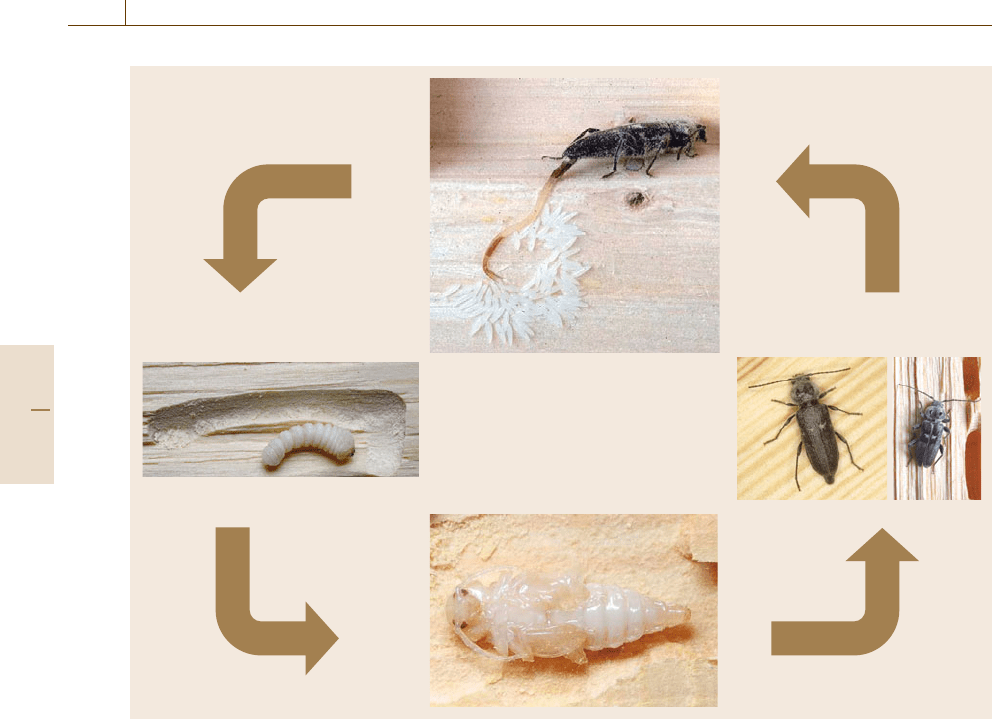
782 Part D Materials Performance Testing
a)
b)
c)
d)
Fig. 14.4a–d Development stages of wood boring beetle using the old house borer Hylotrupes bajulus as an example. All
stages except adult beetles are inside the wood and usually not visible from the outside. (a) Egg laying female; (b) full
grown larva (3 to 6 years old) (c) pupa; (d) adult beetles (female left,maleright)
residual pesticides. The effectiveness of theses insecti-
cides can be evaluated in several laboratory test methods.
Methods for Detecting Insect Attack
The most important types of insects that attack con-
structive timber are beetles and termites. Occasionally,
a few ant species, wood wasps or horntails, wood-boring
moths and a solitary bee may be of some relevance. Nu-
merous indices on the surface wood may directly point
to an attack by wood-feeding insects. Prominent signs
allow differentiating between the possible pests.
Various inspection methods are available to check
for the presence of wood-boring insects: visual, auditory,
x-ray, infrared, and even the use of tracker dogs.
Visual Inspection. The simplest check-up of materials
potentially endangered by insect attack is visual inspec-
tion of the material’s surface, streaming debris from the
material and all signs of insect presence (Table 14.2).
Flight holes: Flight or emergence holes are the exit
sites of emerged adult insects after having completed
their larval stage inside the wood. They appear round or
oval and sharp-edged, not to be confused with screw- or
nail holes. Broadly oval holes are characteristic for ce-
rambycid beetles, whereas a round shape of these holes
points to powder-post or anobiid beetles. However, the
mere existence of flight holes is no final proof for an
ongoing attack, since the completion of beetle develop-
ment and the infestation may have occurred a long time
previous. Additional information is required. New emer-
gence holes appear bright to light yellow in color, like
freshly-sawed wood, and indicate recently emerged bee-
tles with possibly more larvaein the material to complete
their development. The longer an infestation is extinct
Part D 14.2
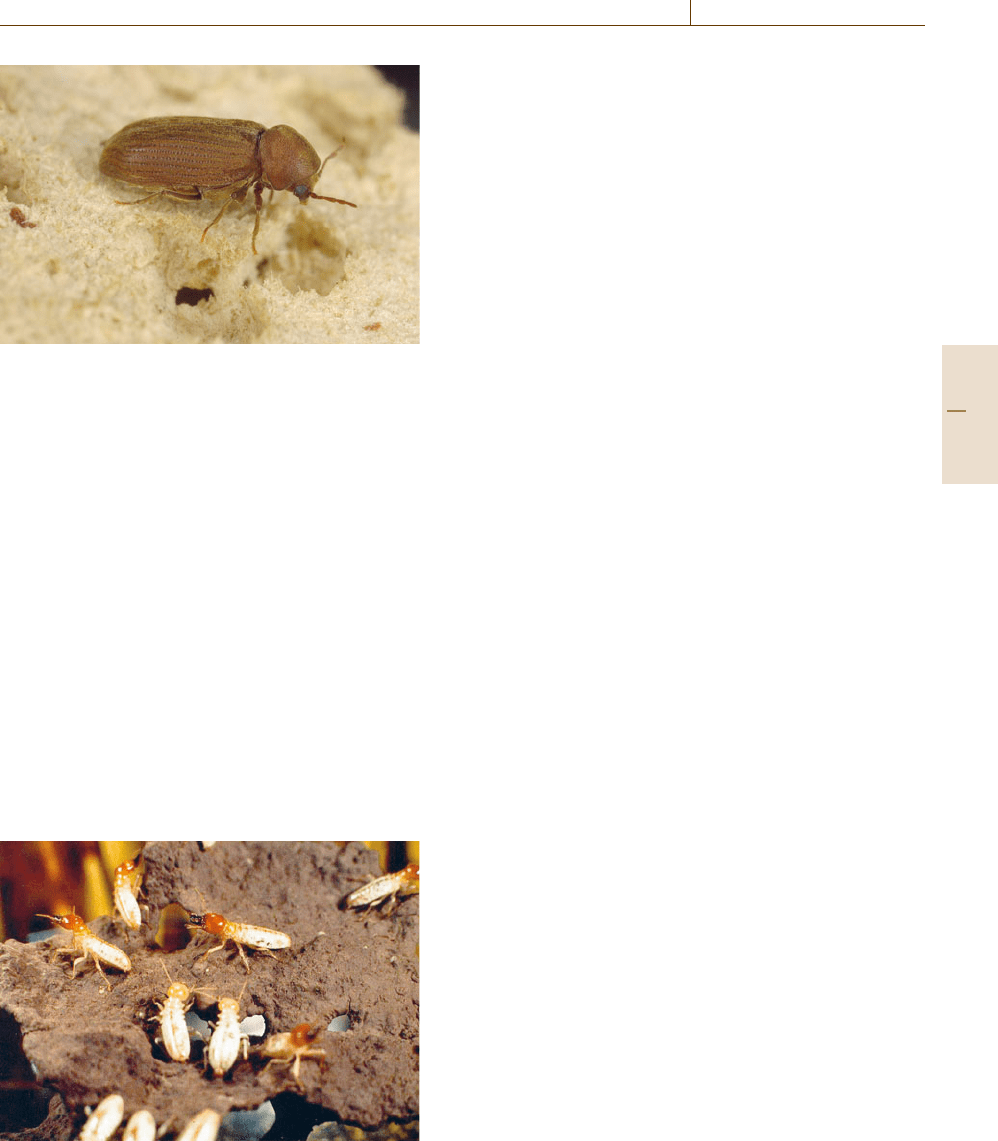
Biogenic Impact on Materials 14.2 Biological Testing of Wood 783
Fig. 14.5 Wood boring beetles Anobium punctatum adult
the more dust is accumulated and oxidation processes
darken the powdery inner edges of the holes over time.
Paint sealed holes from a previous coating may also in-
dicate an already extinct infestation when no fresh holes
are evident. In case of doubt, existing emergence holes
should be marked and the material be rechecked after
time for additional holes to have occurred. The mater-
ial may also be tightly wrapped or sealed with paper, for
new emerging beetles will penetrate the wrap and indi-
cate developmental activity by leaving their exit holes in
the wrap.
The flight holes of dry-wood termites, which may
be confused with the exit holes of anobiid beetles, are
first signs of their presence. They live in small colonies
of up to some hundred individuals entirely in wood that
is moderately to extreme dry. They require no contact
with the soil. Because of their concealed life, colonies
can go undetected for many years inside timber. Often it
Fig. 14.6 Termite Mastotermes darwiniensis;2workerter-
mites at the bottom and 3 soldier termites at the top
becomes visible only when already considerable damage
was produced.
Big round holes, 12 mm wide, mainly outdoors, are
the nest entrances of carpenter bees. The wood below the
hole often shows yellowish fecal streaks. The entrance
is usually guarded by the female bee, giving a humming
sound.
Horntails also emerge through round-shaped flight
holes. Their size can vary between 4 to 6 mm in cross
section and fresh holes occur exclusively in recent cut
and build-in timber during the first three years. This is
because development is completed from eggs which had
been laid by female horntails in the forest on trees declin-
ing or dying from fire, disease or insect damage or other
natural causes. They also infest newly felled and freshly
sawed lumber. Reinfestation of dry structural timber is
most unlikely.
Appearance of the wood surface: The larvae of
wood-boring insects usually start their tunnelling in the
most peripheral parts, leaving a paper-thin layer of the
wood surface untouched. The frass produced by grow-
ing larvae occupies a greater volume than the wood from
which it was produced, and this causes the surface of the
infested wood to have a blistered or rippled appearance.
Occasionally the surface will break, and frass may fall
out through the fine cracks and accumulate on the floor
beneath.
Little mud tubes, so-called galleries, extending from
the ground over exposed surfaces to a wooden food
source are good indicators of the presence of subter-
ranean termites. The tubes are either round or flat and
usually measure at least 8 mm. These termites live in
colonies which can contain thousands to millions of
individuals and are closely associated with the soil habi-
tat where they tunnel to locate water and food, namely
wood.
Termites excavate galleries or tunnels in wood as
they consume it, leaving nothing more than a thin wood-
en layer. These areas are easily crushed with a hard
object (knife, hammer or screwdriver). In the case of ex-
treme damage partly collapsed wood at bearing points
may pinpoint to internal excavation. Noninfested wood
gives a sound resonance when pounding the surface,
damaged wood sounds hollow.
Slitlike openings called windows with some frass
directly beneath are positive signs for carpenter ant
activity. Usually this frass contains fragments of ants
and other insects mixed with the wood fibers, be-
cause unlike termites that consume wood, carpenter ants
scavenge on dead insects, insect honeydew and other
materials.
Part D 14.2
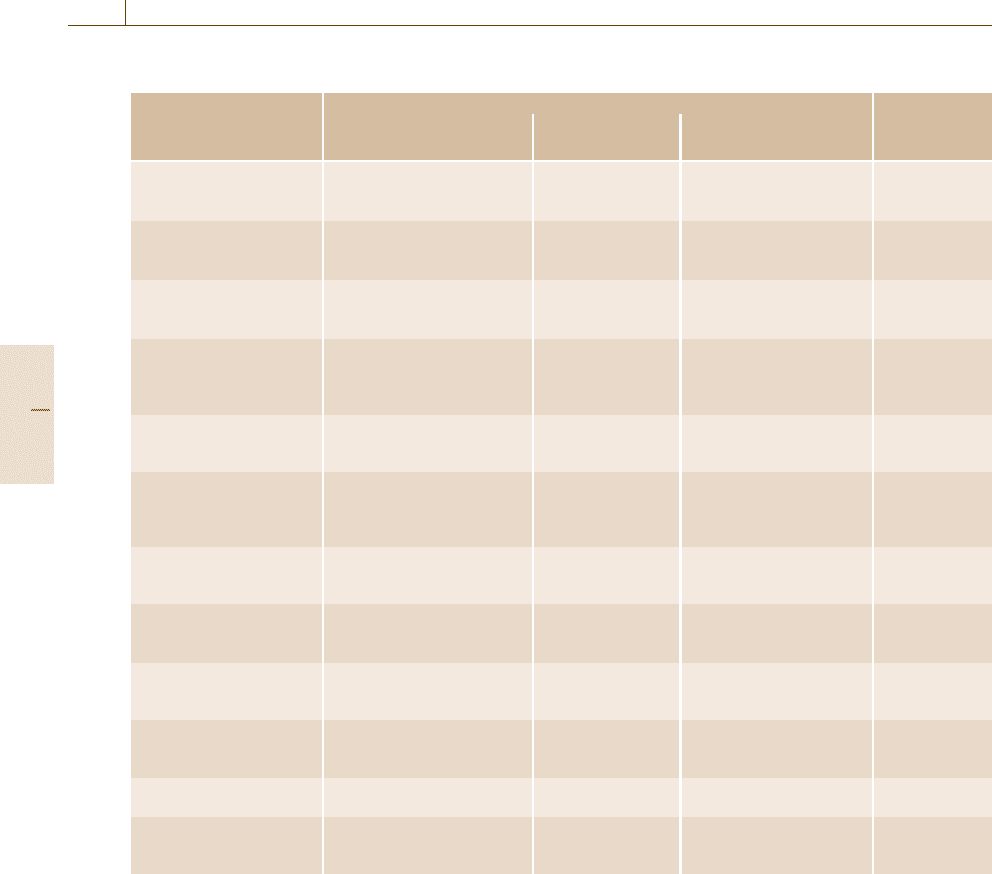
784 Part D Materials Performance Testing
Table 14.2 Characteristics damage by wood infesting insects (modified from [14.18])
Infested material Signs of infestation Most likely
frass holes galleries, tunnels, pest
feeding tubes
Seasoned sapwood of
hardwoods or softwoods
(rarely in heartwoods)
Fine powder with elongate
lemon-shaped pellets, loosely
packed
Exit holes
circular
1.6to3mm
Up to 3 mm circular in
cross section, numerous
and random
Anobiid
powderpost
beetle
Sapwood of hardwoods
primarily, minor in
softwoods
Fine to coarse powder, tightly
packed, tend to stick together
Exit holes
circular
2.5to7mm
1.6 to 10 mm circular in
cross section numerous
and random
Bostrichid
powderpost
beetle
Sapwood of ring and
diffuse porous hardwoods
only
Fine flour-like, loosely
packed in tunnel
Exit holes
circular
0.8to1.6mm
1.6 mm circular in cross
section, numerous,
random
Lyctid
powderpost
beetle
Seasoned sapwood of
softwoods
Very fine powder and larger
cylindrical pellets, tightly
packed in tunnels
Exit holes
oval
6to10mm
10 mm oval in cross
section, numerous in outer
sapwood, ripple marks on
walls
Hylotrupes
bajulus
Unseasoned wood under
bark only, inner bark and
surface of sapwood only
Coarse to fine powder, bark
coloured, tightly packed
Exit holes
circular
1.6to2.5mm
Up to 2.5 mm circular in
cross section, random
Bark beetles
Seasoned dry soft- or
hardwood
Hard elongate pellets of
uniform size, less 1 mm,
six flattend or Concavely
depressed sides
None Hollow tunnels beneath
a thin wooden layer,
sometimes filled with fine
frass
Dry wood
termites
Wood coated with mud
galleries
Fine lamellae of late wood
remain intact
None Hollow tunnel beneath
a thin wooden layer, mud
tubes leading to the wood
Subterranean
termites
Seasoned wood Piles of coarse wood
shavings with insect parts
Slitlike windows Clean smooth galleries Ants,
carpenter
ants
Softwood or softer
hardwood with no bark
Fine wooden debris with
yellowish faecal streaks
Entrance holes
large and circular
12 mm
Smooth walled 12 mm
circular in cross section,
very regular
Carpenter bees
Fresh to slightly seasoned
softwood, very rarely
hardwood
Fine coarse, usually not
outside the wood
Exit holes
circular
4to6mm
Strongvariationinsize,
circular in cross section,
tightly packed with frass
Horntails
Unseasoned wood or
occasionally damp
Fine in texture with granules
being circular
Narrow oval
ragged margins
Indistinct, less than 3 mm
in cross section
Weevils
Unseasoned wood with
bark or occasionally damp
Fine, stacked between bark
and sapwood
Numerous small
entrance and
larger exit holes
Bark is lifted up by frass
deposits
Warf beetles
Lamellar degradation of the cut end of foundation
beams point to the activity of the wood ant Lasius full-
ginosus. This small ant in general starts to attack wood
at the ground level, where it is in contact with mois-
ture and therefore is susceptible for fungus decay. This is
a precondition for an initial attack. Later, by autonomous
moisture intake, together with this symbiotic fungus the
ants progress deeper into the wood thus possibly causing
substantial damage.
Occurrence of frass (bore dust): While feeding, bee-
tles often push out powdery frass from holes which they
have constructed in the infested wood. The frass is piled
below the holes or in cracks of the structures. However,
those piles are not indicative off an active attack, as con-
cussions can cause a release, after an infestation has
already ceased. Furniture or other wooden objects with
past infestations will sometimes be suspected to be rein-
fested when frass or insect parts fall out in the process
of handling or moving. By placing a dark paper beneath
nonmoved objects to detect the appearance of fresh frass
will clarify whether the infestation is active or not.
If the wood surface is probed where tunnelling is
suspected, the powdery borings may be located. The
consistency of the frass ranges from very fine to coarse,
depending on the pest. The size and shape of larval frass
are often species specific. Larger cylindrical frass pellets
Part D 14.2
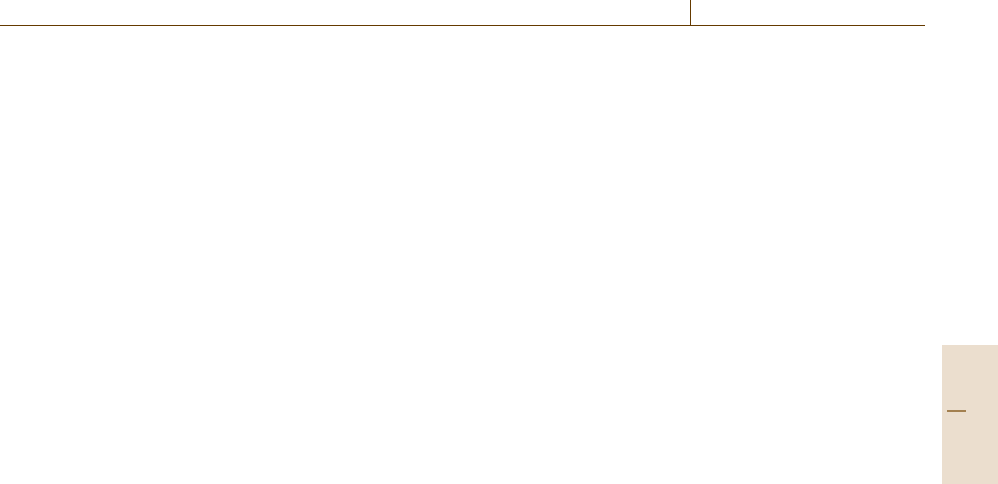
Biogenic Impact on Materials 14.2 Biological Testing of Wood 785
like those produced by the old house borer, Hylotru-
pes bajulus, are typical for cerambicid beetles, whereas
round frass pellets with tip-point edges indicate the pres-
ence of anobiid larvae like Anobium punctatum for ex-
ample. Flour or talc-like frass points to the presence of
powderpost beetles. This will fall out of the emergence
holes while tapping the wood with a hammer. A magni-
fying lens should be used for a reliable inspection of frass
pellets.
Small fecal pellets generally found in the close vicin-
ity of their wooden habitat are good indicators for the
presence of drywood termites. The pellets can vary
in color, depending on the wood that has been con-
sumed. They appear hard, elongate, of uniform size, less
than 1 mm in length, with round ends and six flattened or
concavely depressed sides. The piles do not contain any
other debris such as insect parts or fiber.
A pile of wood shavings outside a hole or opening
is a hint for the presence of carpenter ants. The wood
shavings are coarse and insect parts and bits of insulation
will be mixed among them. These shavings may also be
found in spider webs and window sills close to the nest
site.
The frass produced by carpenter bees is very simi-
lar to those of carpenter ants regarding color and size. It
usually lacks insect fragments.
Damaged wood: The larvae of most wood-boring
beetles develop for several years inside the inner por-
tion of seasoned wood. Tunnelling is most extensive in
sapwood, but it may extend into the heartwood, espe-
cially when it is partly decayed. The size and shape of
feeding tunnels may be a good indication for the caus-
ing pest. However, small tunnels produced by young
larvae of cerambycid beetles at an incipient decay can
easily be confused with those from an old infestation by
anobiid beetles. Therefore, other indices like the shape
of frass pellets are needed for a final proof. The frass in
the tunnels may be loosely to tightly packed and does not
tend to fall out freely from the wood. Some wood-boring
species only attack softwoods, like the old houseborer,
others specifically infest hardwoods like most bostrichid
and lyctid beetles. Some anobiid species will attack both
hardwoods and softwoods. Defrassing of suspected in-
fested timber may expose the feeding tunnels and thus
ease inspection.
Unseasoned hardwood with bark or wood in damp
environments like pit-shafts or seasides may be attacked
by wood-boring weevils or wharf beetles (also known
as wharf borers). Weevil infestation can be differenti-
ated from those of anobiids by the bore dust and frass
which are finer in texture and the individual granules be-
ing more circular. The feeding tunnels are smaller and
the exit holes are narrow oval with ragged or indistinct
margins. Wharf beetles usually deposit the frass between
the bark and the outer sapwood portion, which lifts and
loosens the bark. The larval feeding tunnels are covered
with ambrosia fungi staining the wood slightly dark. The
wood surface may be covered with circular small larval
entrance and larger adult emergence holes. Warf beetles
are, next to submerged marine wood degraders like ship-
worms and certain crustaceans (which do not belong to
the insects and are therefore dealt with elsewhere), eco-
nomically the most important pests in the ship-building
industry.
Wood damaged by carpenter ants (Camponotus spp.)
contains galleries that are very clean and smooth. Ants
do not eat wood, but tunnel into wood to make a nest.
Wood ants like Lasius spp. preferentially excavate the
early wood layers, leaving a lamellar set of late wood
untouched.
Some soil-inhabiting termites (e.g., those of the
genus Coptotermes) decay wood from the surface (ero-
sive decay). They coat it with wide mud galleries usually
underneath and feed on the early wood. Fine lamellae of
the late wood remain almost untouched. Others (e.g., of
the genus Reticulitermes) intrude into the wood and hol-
low out all but a thin surface layer. Drywood termites
simply excavate tunnels and chambers within the timber,
which can be filled with frass. They prefer softwoods and
the sapwood of hardwoods, but they have been recorded
to attack heartwoods as well.
Technical devices can assist in the inspection of
possible infestation sites: the use of an endoscope sup-
plies additional information about the degree of damage;
a moisture-meter is especially useful for detecting ter-
mites in their cavities.
Insects, insect parts: Occasionally, the obvious pres-
ence of adult beetles, wasps, bees or termites will be
noted. As adult beetles emerge in confined structures,
they often are attracted to lights or windows. Mem-
branous insect wings in great number around windows
or beneath lamps are an indication for termite activ-
ity. Insect manuals and determination keys may allow
the identification of the pest. Sometimes insect frag-
ments found in the tunnelled wood or in the frass (wings,
legs, cuticle fractions) may be sufficient for identifica-
tion, however, professional entomological education and
good magnifying devices are required.
X-ray and infrared: Hidden infestations inside the
wood or concealed parts of a building may be recorded
with x-ray machines or infrared cameras. However, the
use of x-ray is very limited due to the lack of safe-
Part D 14.2
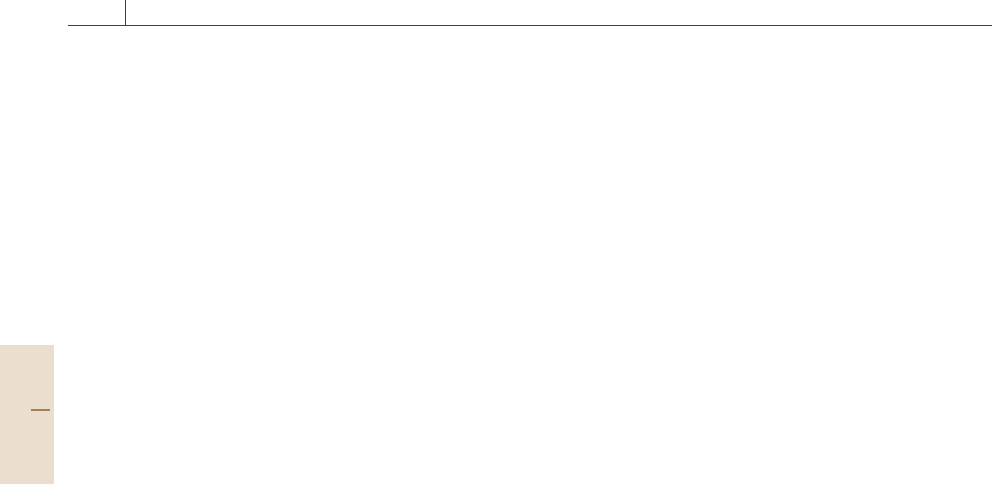
786 Part D Materials Performance Testing
to-use portable x-ray devices and the high costs of
this technique when applied stationary. Infrared cam-
eras record the heat generated by living organisms. They
may be very useful to pinpoint large cryptic infesta-
tion hotspots by termites. The accuracy of the record-
ing, however, depends on the building insulation and
other potential heat sources. In most cases, cost-benefit
considerations do not justify the use of the infrared
technique.
Auditory Inspection. Sounds, generated by the insects’
interactions with their substrate, may be a hint for an ac-
tive infestation. Under certain circumstances, especially
during the quiet nightly hours, auditory inspection and
acoustic detection of wood-infesting insects is possible.
Computer-based devices have been developed to facili-
tate the prospect of success [14.19,20].
Gnawing sounds of beetle larvae: Even in the early
stages of an infestation, the rasping or ticking sounds
made by the larvae while boring can be heard. This
sound may be detected from a distance of 1–2 m, day
and night, at infrequent intervals. The amplitude and fre-
quency spectra of the feeding sound appear to be species
specific.
Tapping sounds of adult beetles: Adult beetles of the
death-watch beetle tap their heads on the wood as mat-
ing signals. The tapping noise is made by both sexes and
can be heard unaided. It can be imitated tolerably well,
at least to the extent of stimulating surrounding beetles
to themselves start tapping.
Running termites: With the help of high-resolution
contact microphones attached to the wood to be tested
the sound of termites running in their tunnels may be de-
tected.
Alarm signals of carpenter ants: An active colony
may produce a dry rustling sound, similar to the crin-
kling of cellophane. After identifying a potential nest
site, tapping against it with a screwdriver may cause a re-
sponse clicking of alarmed ants. A listening device, such
as a stethoscope, may be useful when conditions are
quiet and outside noises are at a minimum.
Swarmers. The occurrence of swarming insects is evi-
dence for the presence of ants or termites. Because of the
consequences for possible remedial action, it is essential
to know the major differences between those two insect
groups. Ants, like most hymenoptera, have much larger
forewings than hind wings. Termite wings all are of the
same size; they break off easily. The antennae of ants are
kinked, those of termites are straight. The thorax includ-
ing the first abdominal segment (first abdominal tergum)
and the rest of the abdomen in ants are joined by a nar-
row waist, while the thorax of termites is broadly joined
to the abdomen.
Swarming termites in the exterior only indicate a ter-
mite infested area and not necessarily a termite attack.
If, however, the swarmers are observed flying out of the
structure from around windows, doors, porch columns
or other wood constructions, then there might be some
concern. Indoor swarmers point to the presence of ei-
ther soil-inhabiting termites underneath the structure or
drywood termites, which live in the house framework
or in wooden furniture. An entomologist should be con-
sulted for identification of the pest species, because
control measures are specific for the different insect
groups.
Termite Dog. Specialized dogs, trained to smell the
trail odors of termites, are used to detect termites in-
and outside of properties. According to an investigation
at the University of Florida, the success rate is up to
96% [14.21].
Sticky Traps. Sticky traps, baited with the female sex
pheromone, mostly used for detecting and monitoring
beetle populations, are marketed for Anobium puncta-
tum. It only has limited use for mass-trapping by setting
out large numbers of traps in infested areas to catch
a large number of beetles and thus reduce the population.
As the traps only attract males and trap attractiveness
has to compete with the natural pheromone of female
beetles, the number caught may be too low to prevent
mating. Therefore, pheromone traps are mostly used for
detecting and monitoring beetle populations only.
Control. Knowledge about the particular insect species
responsible for the impact may determine the con-
trol measure. Even prior to a thorough investigation of
the dwelling and probable consequent treatments, the
significance of a possible infestation has to be con-
sidered. A differentiation between wood-feeding and
wood-breeding insects can assist in estimating the de-
gree of a damage.
The impact on timber by wood-breeding insects can
mostly be neglected, as they only attack wood for com-
pleting their development. They are only active in green
timber. Debarked wood and seasoned lumber is never in-
fested. Prominent examples are the following.
•
Green wood beetles: Their larvae feed in the cam-
bium, the thin layer of plant tissue between bark
and wood. They usually groove the sapwood. At
Part D 14.2
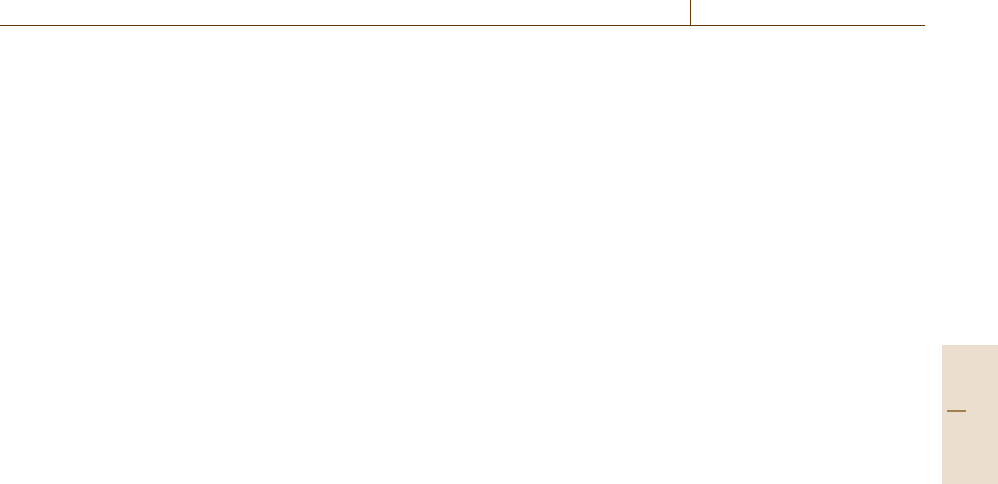
Biogenic Impact on Materials 14.2 Biological Testing of Wood 787
the end of their development, old larvae tunnel into
the wood and pupate. The emerging beetles leave
through those tubes. On the surface of plane timber
the flight holes may be visible, which can be con-
fused with those from wood-feeding species.
•
Bark beetles: Their larvae also feed in the cambium
zone of living trees, fallen trees and logs. They ex-
cavate a characteristic tunnel called a gallery usually
parallel to the grain and may penetrate superficially
into the sapwood. Timber is not attacked unless of
a high moisture content.
•
Wood wasps: Wood wasps, also known as horntails,
are capable of penetrating solid wood, especially of
debilitated, dying and freshly felled trees, in which
the eggs are laid. The damage is characterized by
round boreholes densely packed with frass. Emer-
gence holes are circular in cross section and up to
8 mm in diameter.
Methods for Testing Insect Resistance
The resistance of wooden materials against insect attack
can be material-specific or generated through the modi-
fication of the wooden matrix or the application of wood
preservatives, namely insecticides. Several general and
specific standard testing procedures are available which
allow resistance data obtained in the laboratory to be
transferred to field situations. Specific standards may
differ for either preventive or curative measures. The
test organisms used in these testing standards repre-
sent the economically most important pests. Hylotrupes
bajulus represents a softwood-infesting cerambicid bee-
tle, Lyctus brunneus an exclusively hardwood-infesting
beetle, and Anobium punctatum an opportunist. Tests
with termites are usually carried out with subterranean
species like Reticulitermes santonensis or Coptotermes
formosanus or others.
Specific Tests for Resistance Against Wood-Boring
Beetles (Preventive Measures). The eggs of wood-
boring beetles are deposited in cracks and crevices of the
wood. Larvae of wood-boring beetles therefore hatch in-
side the wood and begin tunnelling immediately. This
fact was generally taken into account when test proce-
dures were designed. The natural resistance of wood
against insect attack may also be tested applying the fol-
lowing standards.
•
European Standard EN 20: Determination of the pre-
ventive action against Lyctus brunneus (Stephens) –
Part 2: Preservatives application fully impregnated
wood treatment (laboratory method).
•
European Standard EN 21: Determination of toxic
values against Anobium punctatum (De Geer) by
larval transfer (laboratory method). This standard
describes a laboratory test method which gives a ba-
sis for assessment of the effectiveness of a wood
preservative against Anobium punctatum. It allows
the determination of the concentration at which the
product prevents the survival of Anobium puncta-
tum larvae in impregnated wood of a susceptible
species. Although an infestation normally starts from
egg-laying, a larval transfer test is applicable when
considering the situation of treated wood being put
into contact, during repair work, with wood that
might be infested.
•
European Standard EN 46-1 and EN 46-2: Wood
preservatives – determination of the preventive ac-
tion against recently hatched larvae of Hylotrupes
bajulus (Linnaeus) (laboratory method). These stan-
dards make it possible to determine whether recently
hatched larvae are capable of boring through the
treated surface of a susceptible wood species and of
surviving in the untreated part of the test specimen.
For this purpose, the procedure seeks to reproduce
normal egg-laying conditions existing in cracks in
the wood, which provide the principal egg-laying
sites. It takes account of the fact that, if larvae pass
through the treated surface, they will then tunnel in
the direction of the least protected regions of the
wood.
•
European Standard EN 47: Determination of the
toxic values against recently hatched larvae of Hy-
lotrupes bajulus (Linnaeus) (laboratory method).
This standard specifies a laboratory test method
which gives a basis for the general assessment of
the effectiveness of a wood preservative against Hy-
lotrupes bajulus by determination and comparison of
the concentration at which the product prevents their
survival in totally impregnated wood of a susceptible
species.
•
European Standard EN 49-1: Determination of the
protective effectiveness against Anobium puncta-
tum (De Geer) by egg-laying and larval survival –
Part 1: Application by surface treatment (laboratory
method). This part of EN 49 describes a laboratory
test method which gives a basis for assessment of the
effectiveness of a wood preservative, when applied
as a surface treatment, against Anobium punctatum.
It allows the determination of the concentration at
which the product prevents the development of in-
festation from egg laying. The method simulates
conditions which can occur in practice on timber
Part D 14.2
